Learning how to start a craft blog is a great way to share your love of crafting with the world, and it can also be a lucrative way to make money online.
In this post, we’ll give you tips on how to start a craft blog and make money from it. You will learn how to choose your craft blog’s niche, create a craft blog in WordPress and write blog posts. Then I will show you how to promote your craft blog to get traffic along with how to monetize your craft blog to make money.
By the end of this guide, you will be able to build a successful craft blog from scratch.
If you have any questions along the way, just drop a comment and I will help you out.
So let us jump right in.
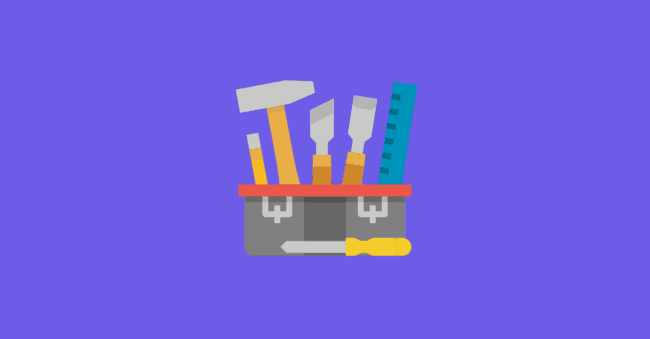
How to Start a Craft Blog in 7 Steps
- Define Your Craft Blogging Goals
- Choose a Craft Niche
- Pick & Register a Blog Domain Name
- Setup WordPress
- Write & Publish Blog Posts
- Promote Your Craft Blog
- Make Money With a Craft Blog
1. Define Your Craft Blogging Goals
The first step in starting a craft blog is to clearly define your goals. Are you looking to share your love of crafting, promote your own handmade crafts, or build an online business?
Once you know what you hope to achieve with your craft blog, you can then choose a direction for your blog that aligns with those goals and start building an audience around your craft blog.
What is a Craft Blog?
A craft blog is a type of online publication that focuses on sharing and promoting various types of crafting projects. Many craft blogs also engage in affiliate marketing or selling digital products to monetize their content, though this is not always the case.
Why Start a Craft Blog?
There are many reasons why you might want to start a craft blog. The benefits of starting a craft blog include:
- Build an audience around crafting
- Become an influencer in the crafting space.
- Connect with other crafters
- Promote and sell your own handmade crafts.
- Make money writing about crafting
How much money can you make from craft blogging?
You can make $15-$25 for every 1000 ad views on your craft blog. An SEO optimized blog post can get anywhere between 300 to 1000 visits per month. So, a craft blog with 100 blog posts can make as high as $2500 every month. You can make even more money if you monetize with affiliate marketing and digital products.
2. Choose a Craft Niche
Now that you know what a craft blog is and why you should start one, it’s time to choose your craft blog niche. Your niche is the specific topic that your craft blog will focus on, and it can be any topic related to crafting.
Why choose a niche?
Choosing a niche allows you to focus on a specific area of crafting that you are passionate about. This will make it easier for you to come up with content ideas, connect with your audience, and build a loyal following.
If you blog about everything, you will end up spreading yourself too thin and creating content that is uninspired and generic.
Finding Your Ideal Niche
To choose a niche for your craft blog, think about what you are passionate about when it comes to crafting. What are your favorite crafts to do? What do you like to make?

For example, if you love to knit, then you could start a craft blog that focuses on knitting projects and patterns. If you are into scrapbooking, then you could create a craft blog that showcases your scrapbooks.
Some popular craft blog niches include:
- Sewing
- Paper Crafts
- Crochet
- Home Decor
- Home Decorating
- Handmade Jewelry
- DIY crafts for kids
- Painting
- Knitting patterns and tutorials
You can also choose a niche based on your unique perspective or approach to crafting. For example, if you are a stay-at-home mom who loves to craft, you could start a blog about how to craft with kids.
Another option is to choose a niche that is underserved in the crafting space, such as how to make unique handmade gifts.
Examples of Craft Blog
To help you draw inspiration, here are a few examples of successful craft blogs that have built large audiences and thriving online businesses:
1. Make It and Love It
Make It and Love It is a blog about crafting, sewing, and DIY projects. The site includes tutorials, patterns, and ideas for creative projects.
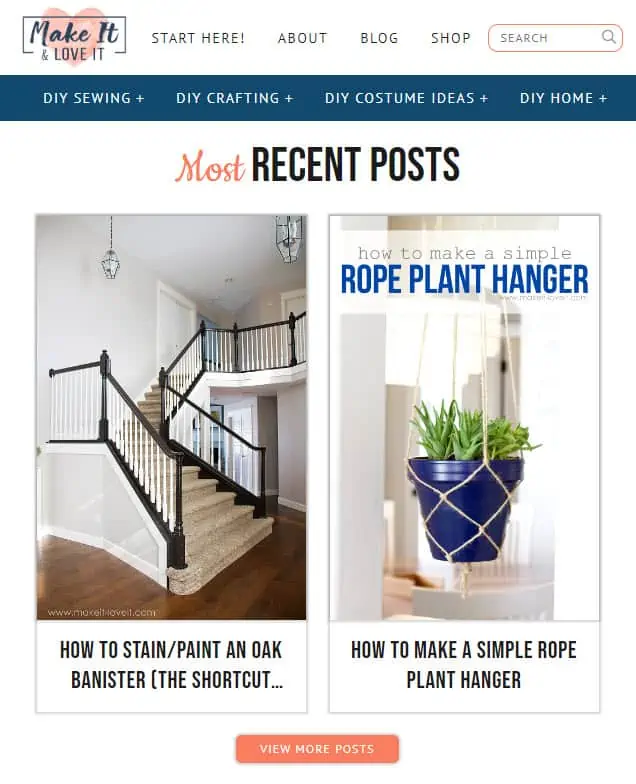
2. Damask Love
Damask Love is a blog about crafting, paper crafts, and party planning. This is a blog by Amber Kemp-Gerstel who was a contestant on NBC’s Making It and also hosts a family crafting show on Disney+.
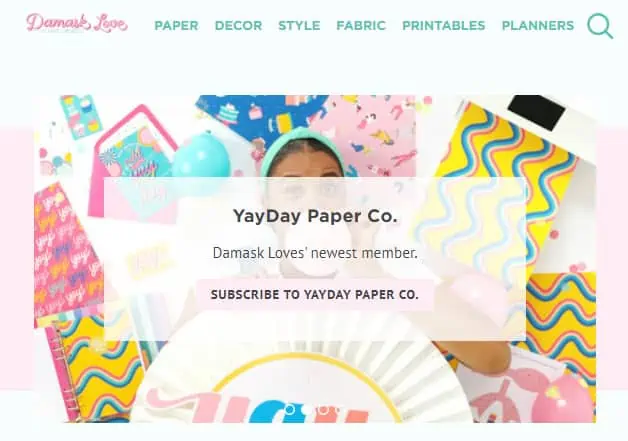
3. Craftaholics Anonymous
Craftaholics Anonymous is a blog about all things crafting. The site includes craft tutorials and creative ideas for home, kids, and holidays.

4. Skip to My Lou
Skip to My Lou is a blog about crafting, cooking, and entertaining. The site includes tutorials, tips, and ideas for making homemade scratch art paper, sewing gifts, throwing parties to cooking delicious food.
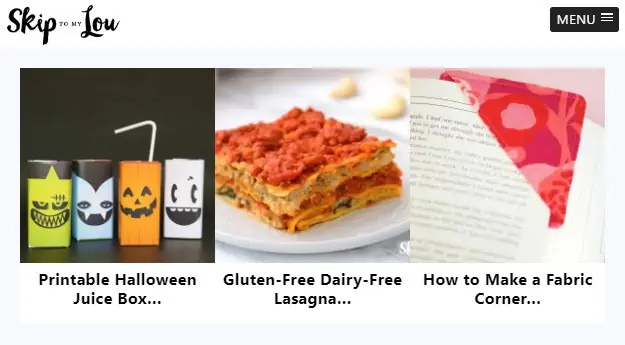
5. P.S – I Made This
P.S – I Made This is a blog about fashion, DIY, and lifestyle. This site is designed to inspire and empower people around the globe to cultivate their inner creativity and embrace the ever-growing do-it-yourself (DIY) way of life.
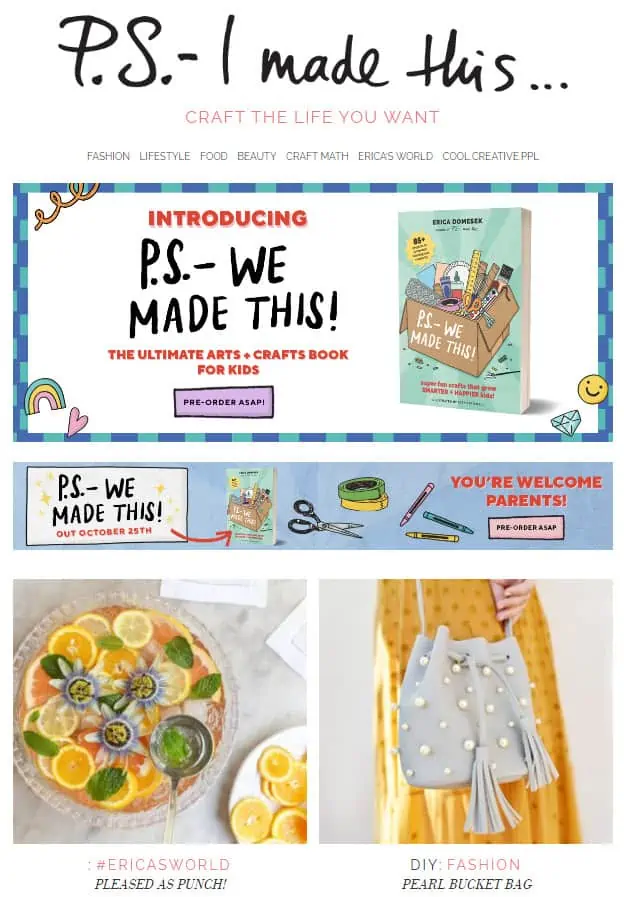
Note on Seasonal Niches
If you are thinking about starting a seasonal niche blog, such as a blog focused on Christmas crafts, keep in mind that your traffic and revenue will be poor for most of the year and will peak during the holiday season. Try to avoid seasonal niches, to begin with and focus on niches that are popular throughout the year.
3. Pick & Register a Blog Domain Name
Once you have chosen your niche, it is time to brainstorm a few names for your craft blog.
We recommend you keep your craft blog’s name to two words (Example: Craft Gossip). One of the two words should be a keyword from your niche. The other word can be something that makes your website brandable. For example, our blog teaches people how to make passive income, so we have named it Passive Book.
Here are some of the words that you can mix and match into your blog name:
- Craft
- DIY
- Knit
- Knitting
- Sew
- Stitch
- Paint
- Jewel
- Jewellery
- Soap
- Bags
- Hats
- Scarves
Use a Business Name Generator to brainstorm the name of your blog.
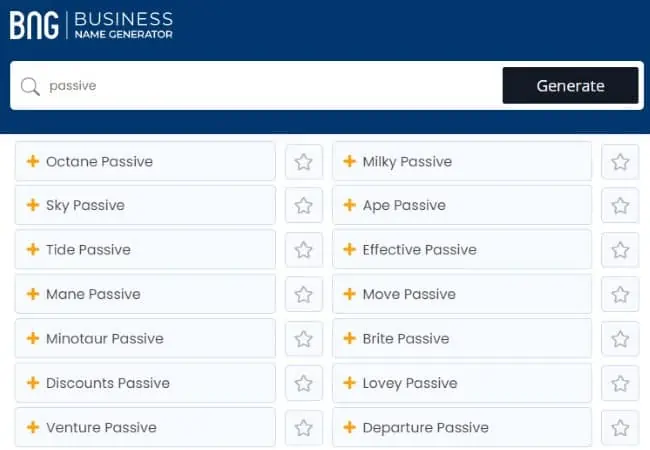
You can also use your own name for your blog. But if you ever plan to sell your website in the future, it is much more difficult to transfer your brand to the buyer when it is your name.
Check Domain Name Availability
After you have brainstormed a few names for your craft blog, you should check if the .com domain name is available.
A blog’s domain name is the web address for that blog. It is how people will find your blog online. It is usually your domain name followed by .com.
You must check if both the .com domain name and the social media handles are available. You can use Namechk to check the availability of both your domain name and social media handles.
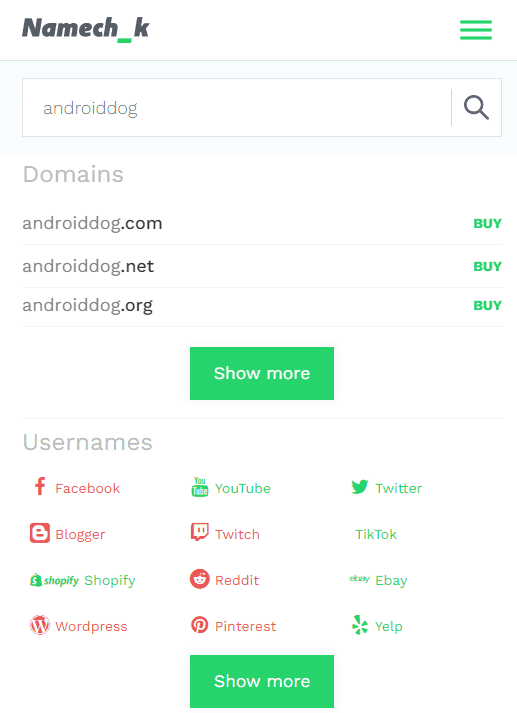
Here are a few things to keep in mind when selecting a domain name:

- Choose a .com domain name. 86% of the internet uses .com, so your visitors are likely to try visiting your blog by typing .com. Avoid other extensions like .net or .org.
- Don’t include hyphens and numbers.
- Do not use words with multiple spellings (for example colour vs color).
- Shorter domain names are better. Try to keep it under 12 characters.
- Spelling & Pronunciation should be easy and intuitive.
- It should be easy to remember.
- Avoid words that can be misread together. For example, therapistjohn.com can be read as Therapist John or The Rapist John.
- Make sure it’s not trademarked or copyrighted by someone else. The AI writing software Jarvis.ai had to rebrand to Jasper.ai because Marvel sued them for the Iron Man reference. Lawsuits will happen once your blog is established.
Register a Domain Name
Once you decide your domain name it is time to register it.
You should register your domain with NameCheap because you will get domain privacy for free. Other providers charge $12 per year for domain privacy. Without domain privacy, your name, home & email address will be accessible to the public.
Step 1: Go to NameCheap. Enter your domain name with the .com extension.
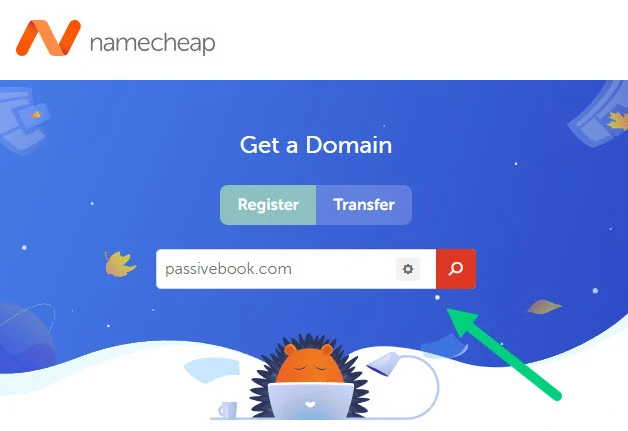
Step 2: Select the .com extension and click the Add to Cart button.
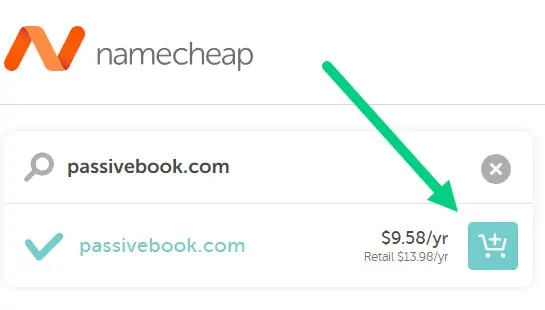
Step 3: After adding the domain to the cart, click on the Checkout button.

Step 4: Enable Domain Privacy that comes for free along with auto-renew. You don’t need any other paid addon.

Step 5: Click on Confirm Order. Pay to complete your purchase.
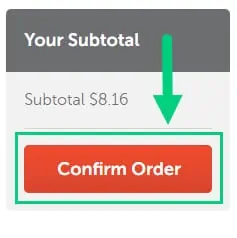
Step 6: Log in to Namecheap and click on Domain List ❶ in the left sidebar and then click Manage ❷ next to the domain you just purchased.
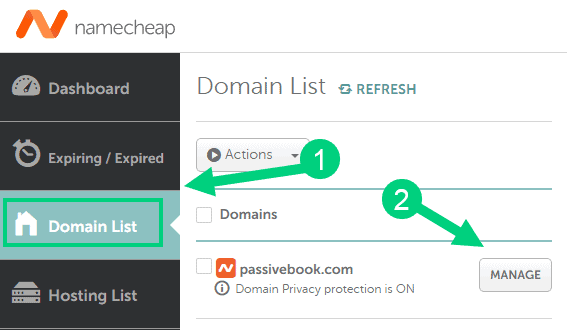
Step 7: Under the Nameservers section, select “Custom DNS” from the dropdown ❶. Then enter the following two nameservers ❷ ns1.bluehost.com and ns2.bluehost.com as shown in the image. Then click the green tick ❸ to save. If you use a hosting provider other than Bluehost, enter their nameserver values in this step instead.
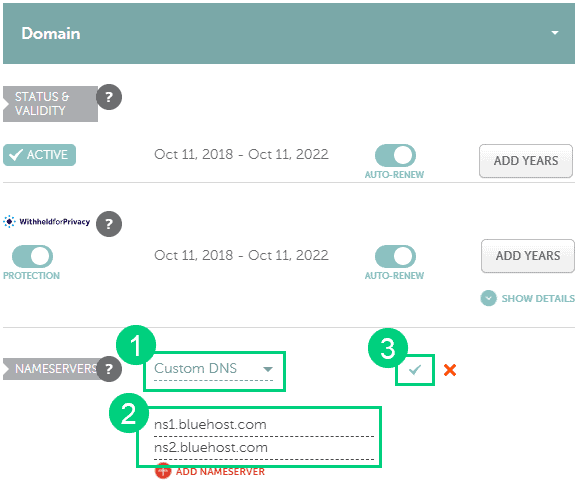
Can I get a free domain name?
Your web hosting provider might give you a free domain name for one year but they charge $12 for domain privacy which is free in Namecheap. From the second year, you will pay for both the domain and privacy which will cost you more than $20+. So it is cheaper to just register your domain with Namecheap from the beginning. Also using different companies for web hosting and domain registration will allow you to easily switch your blog host later without transferring domains.
Can I change the name of my blog later?
You will lose your search engine rankings if you change your blog’s name once it gets links from other websites. It will take as long as a year or more for you to regain the lost traffic. It is possible to mitigate problems by having proper redirects. But you will have to renew both your old and new domains every year. So try to avoid changing your blog’s name once it is established.
4. Setup WordPress
The next step is to get your blog up and running in WordPress.
WordPress is the most popular website builder in the world and makes building your crafts blog easy without learning how to code.
Why Choose WordPress.org?
There are many blogging platforms but the self-hosted wordpress.org powers 70% of blogs on the internet. 42% of all websites on the internet use WordPress. Here are some of the reasons for its popularity:

It’s Free – You can download, install, and use WordPress without paying anything.
Flexibility – You can use WordPress to create just about any kind of website, such as a blog, forum, portfolio, business website, or e-commerce store.
Easy to Use – WordPress is simple and easy to use even if you don’t have any programming experience.
Host Your Own Website – With WordPress, you host your own site on your own server. You have complete control over how your site looks and works.
Support – The WordPress community is huge. If you need help, you can usually find it for free.
Search Engine Optimization (SEO) – WordPress websites are easy to optimize for search engines like Google, Bing, and Yahoo.
WordPress.org vs WordPress.com
There are two types of WordPress. They are WordPress.com and WordPress.org.
WordPress.com is a hosted platform, which means that you don’t need to worry about hosting your website or installing WordPress. All of that is taken care of for you by WordPress.com. But the downside of using WordPress.com is that you won’t have as much control over your website. For example, you can’t install plugins or themes and you’ll be not be able to monetize your site. You can also not add your own domain name.
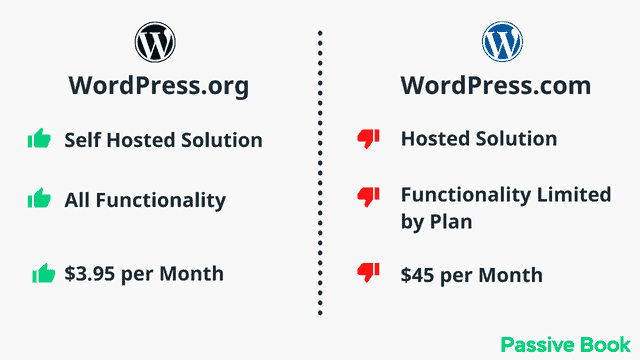
WordPress.org is a self-hosted platform, which means that you’ll need to find a web host and install WordPress yourself. But the upside of using WordPress.org is that you’ll have complete control over your website. You can install any plugins and themes that you want, and you can monetize your site however you want.
For these reasons, we recommend using WordPress.org to create your craft blog.
Why Avoid Free Blogging Platforms
There are many free blogging platforms such as Blogger, Tumblr, and WordPress.com. While these platforms may be tempting because they are free, we recommend avoiding them for your craft blog.
The reason for this is that you won’t have as much control over your website if you use a free platform. For example, you cannot install your own plugins or themes, and you will be limited in the ways you can monetize your site.
Your blog can be deleted by the platform for no reason and you will only be shown the following screen when you try to access your content.

If you’re serious about building a successful craft blog, then it’s worth investing your efforts into building a self-hosted WordPress blog from the very beginning. This way you can have full control over how your website looks and how it operates. With WordPress, setting up your blog is easy and can be done in just a few minutes.
How much does it cost to start a craft blog?

It will cost you $2.95 per month to host your WordPress craft blog in Bluehost. A domain will cost you $12/year. So that is a total of $4.2 per month, which is less than the price of Netflix for all the unlimited features that a self-hosted WordPress blog has to offer.
What to do if you already have a free blog?
If you’re currently using a free blogging platform like Blogger, Tumblr, or WordPress.com, it’s easy to migrate to WordPress using the free import plugin. The plugin will allow you to copy all of your posts, pages, comments, and images from your old blog to your new WordPress blog.
Install WordPress in Hosting
To install WordPress, you need to get hosting. Hosting is the space on a web server where you store your blog files. When someone types in your domain name (www.example.com), the host’s server sends those files back to your visitor’s browser, allowing them to view your site.
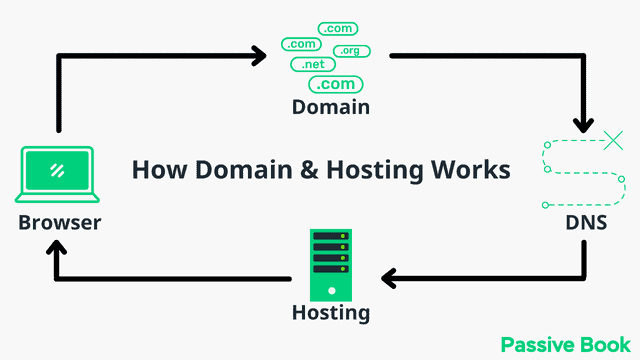
For this guide, we will use BlueHost as our web host. It is a cheap hosting that is extremely easy for beginners to set up. If you use any other web host, the steps will be the same but the user interface may be slightly different.
1. Go to BlueHost using this link to get a special discount. Select WordPress > WordPress Hosting from the top menu.
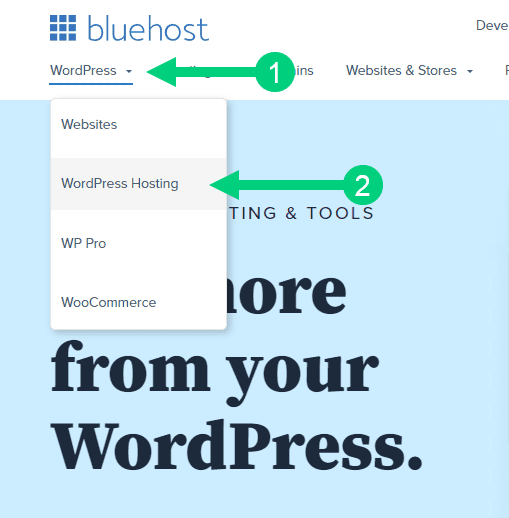
2. Click on the button you see on this page and you will be taken to the pricing section.

3. Select the Basic Plan. You can upgrade to a different hosting plan as you grow.
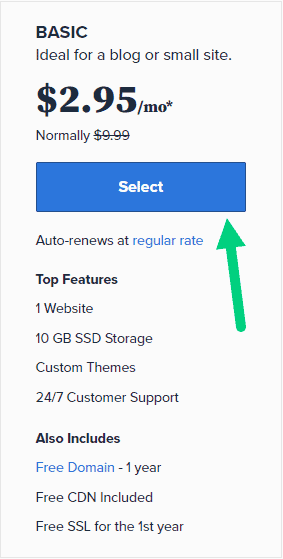
4. If you already have a domain name that you purchased with Namecheap you can put that in the “Use a domain you own” ❶ section. If you don’t have a domain name yet, choose the “Create a New Domain” ❷ to purchase a new domain.
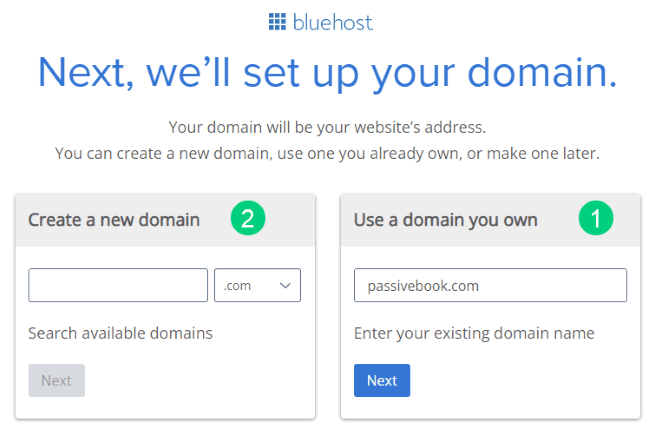
5. In the next screen, enter your information. Uncheck all package extras. If you purchase your domain through Bluehost instead of Namecheap, you may want to enable Domain Privacy. You won’t see the Domain Privacy option if you bought your domain through Namecheap. Namecheap will give you this Domain Privacy for free.
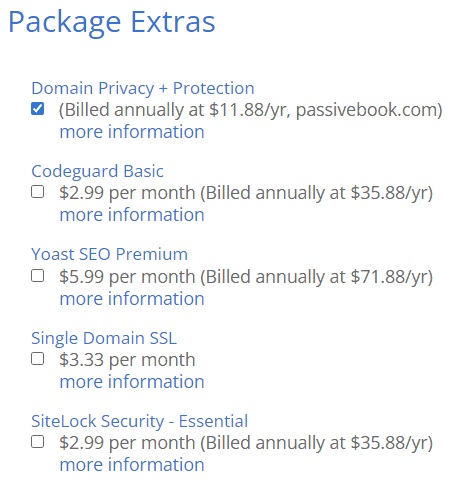
6. Once you have successfully paid, you will be prompted to set a password. Click on the “Create your Password” button.
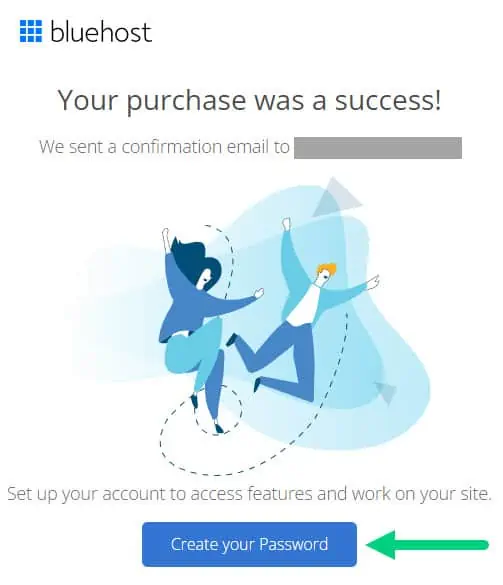
7. Enter your password and create your account. If you lose this password, you can reset it.

8. After you set your password, log in to Bluehost.
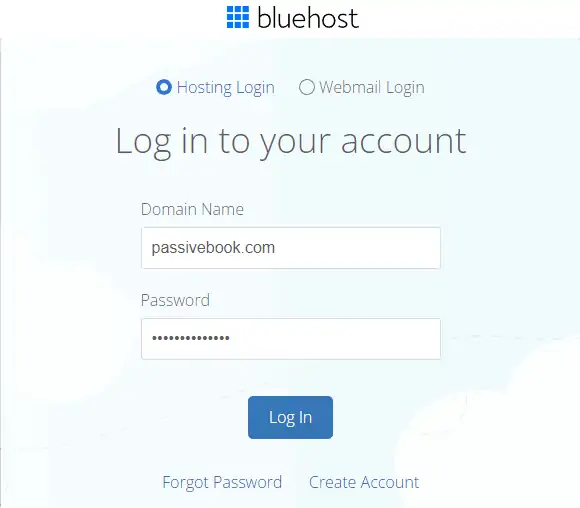
9. Click on the Create your website button on the following screen. This will start a Bluehost Wizard, just click Skip this step wherever possible.

10. On the following page, click “No help needed” or “Skip this step”. We don’t want Bluehost to limit our customization options.
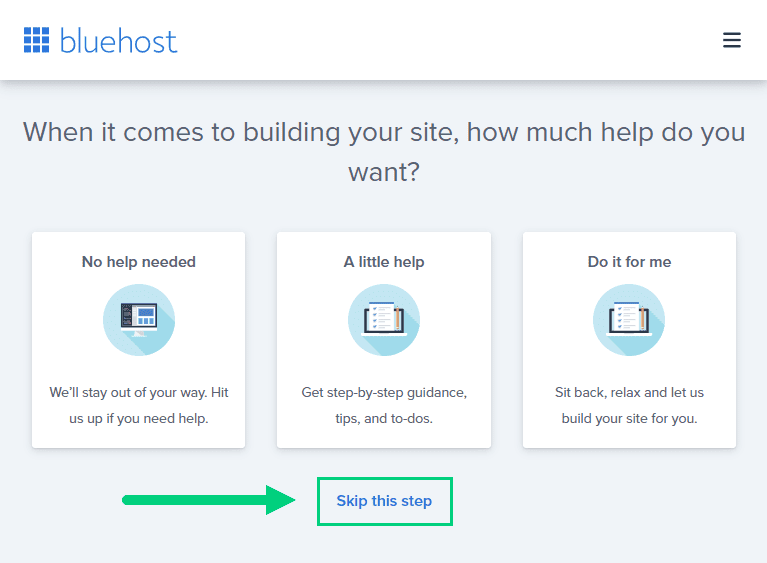
11. On the next page, you will be asked about the purpose of your website. You can choose from any of the available options.
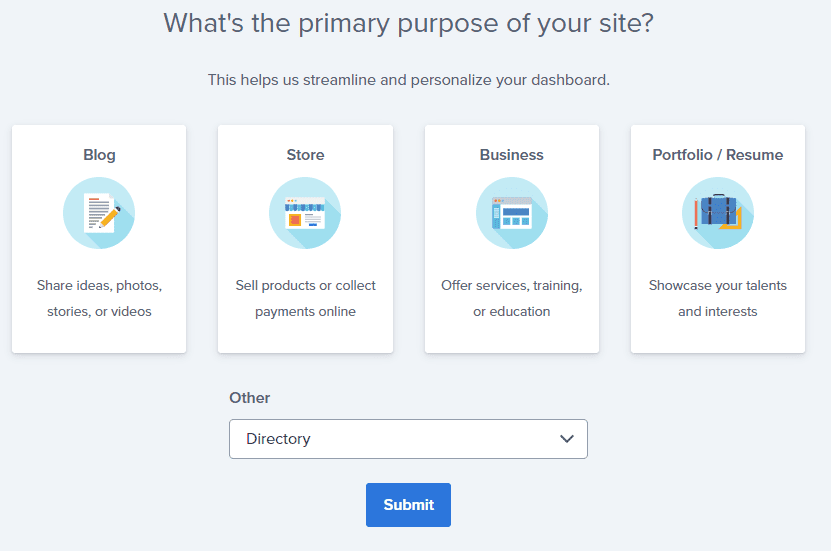
12. On the next page, click Skip this step.

13. On the following page, enter the blog’s name and tagline. You can change this later so feel free to click “Skip this step” or enter something as a placeholder and click Continue.
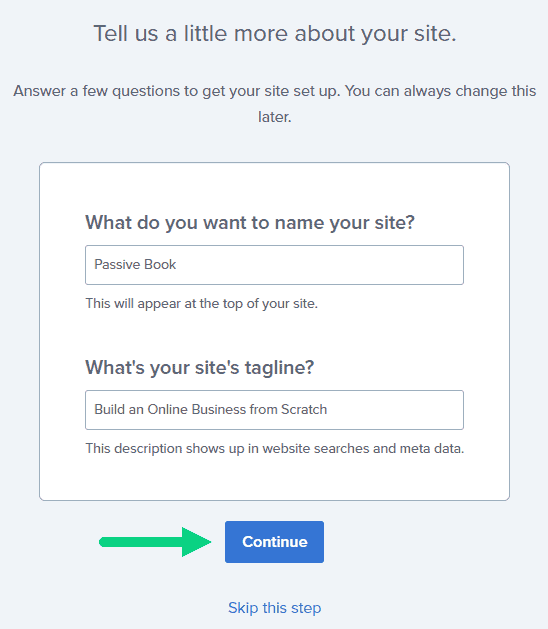
14. Finally you will be asked how you want to build your website. Choose “Limitless customization” to have all the options.
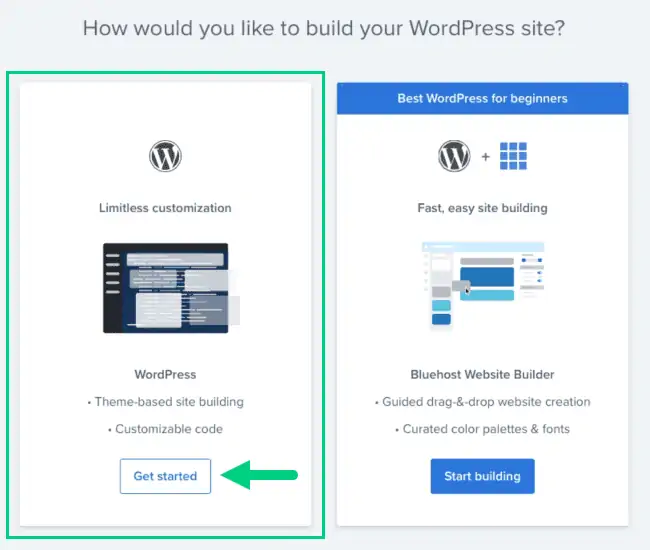
15. You can see your blog by going to yourdomain.com. Go to the Bluehost dashboard and click on the My Sites tab ❶ in the left sidebar and click on the “Manage site” button ❷.

16. Your WordPress site has separate login credentials different from the ones you use to log into Bluehost. You can use this to log in to the WordPress dashboard directly without logging into Bluehost. To get this:
❶ Click on Users on top.
❷ You will be able to see your username and email that you can use to log in to WordPress.
❸ If you click on the three dots you will see the option to Reset your password. ❹
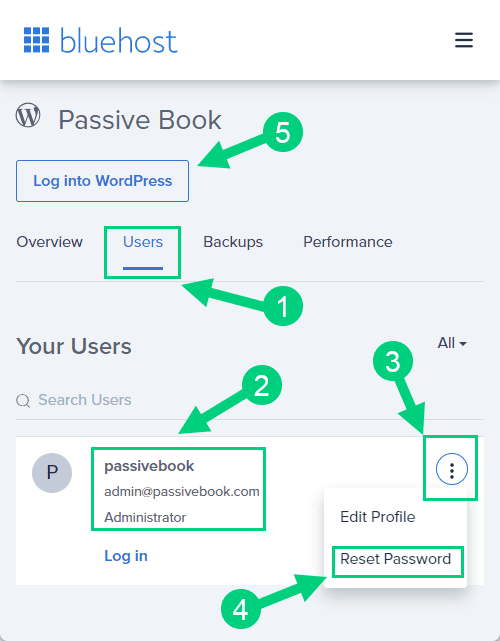
You can log into WordPress from the Bluehost dashboard by clicking the Log in to WordPress button ❺. But it is not recommended you rely on this as your primary login method because you will get locked out of your site if you ever change hosting providers.
17. You will be taken to the WordPress dashboard where you can reset your password ❶. If you don’t like the username Bluehost created for you, you can Add a New User ❷.

18. If you are adding a new user make sure you specify the user role as Administrator ❶. You can log in as the new user and safely delete the default user created by Bluehost.
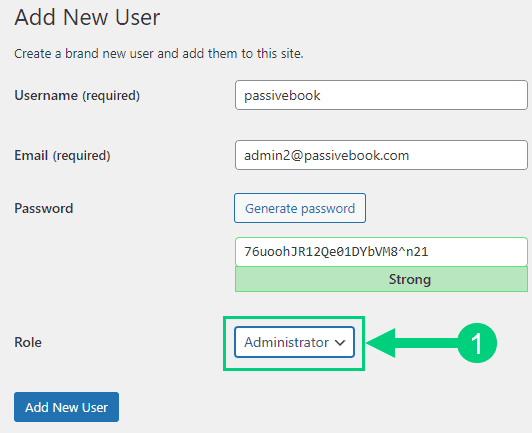
Congratulations! You have successfully set up WordPress.
Configure WordPress
Now that you have the basic version of WordPress installed, it is time to customize it to make it look and feel the way you want.
Login to WordPress Dashboard
Visit yourdomain.com/wp-admin to access the WordPress dashboard.
The WordPress Dashboard is the main area where you will manage your website. From the Dashboard, you can access all of the tools and features that WordPress has to offer. You can also configure how your website looks and works from the Dashboard.

Use the Email and Password you provided during installation to log in to your WordPress dashboard. If you don’t have a password, use the “Lost your password?” to generate a new password.
Install WP Themes
A WordPress Theme is a collection of files that determine how your website looks. When you install a WordPress Theme, it changes the entire design and layout of your website.
Your new WordPress blog will be installed with a default blog theme that doesn’t look very great.
To install a new WordPress Theme:
Go to Appearance > Themes > Add New in your WordPress dashboard.
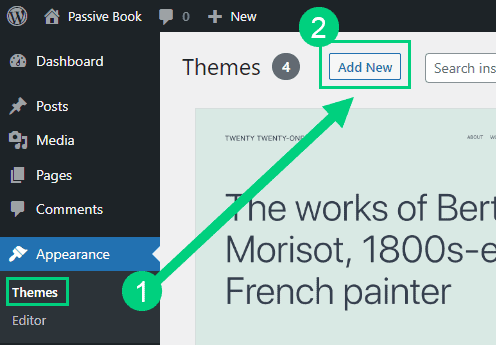
Use the search to find a theme that you like ❶. Before you install the theme, you can see a demo of the theme and learn about its features from the preview screen ❷. If you like the theme, you can install it by clicking the install button ❸. You can also upload a theme from a file on your computer ❹.
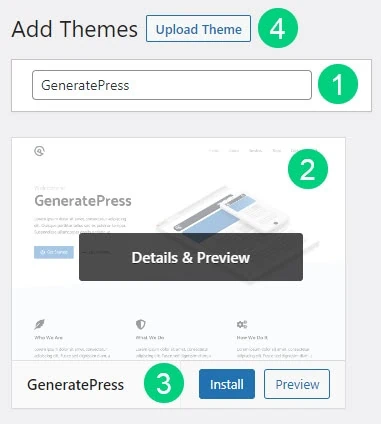
Once installed, click the Activate button to enable the theme.
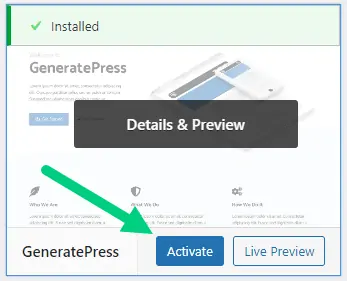
Although you can use a free theme (there are thousands of free themes available), we recommend using a premium theme.
Premium themes not only reduce your website’s load time but also help you customize your website to your heart’s desire.
Here are the premium themes we recommend:
There are also several custom-made craft blog themes. These themes tend to be bloated with poor code which will slow down the performance of your website. We suggest getting one of our recommended themes for a fast website with unlimited customization possibilities.
Install WP Plugins
A WordPress Plugin adds features and functionality to your WordPress website. There are over 50,000 WordPress plugins available for free on the WordPress Plugin Repository.
Too many wordpress plugins can slow down your blog site. So before you install new plugins, it will be worth clearing out any existing plugins that your hosting provider installed by default.
Plugins first need to be deactivated before they can be deleted.
❶ Go to WP Admin > Plugins > Installed Plugins
❷ Click on the checkbox to select all plugins.
❸ Select Deactivate from the drop-down.
❹ Click Apply.
❺ Repeat the above steps but select “Delete” instead of “Deactivate” from the dropdown in ❸ to delete all the deactivated plugins.
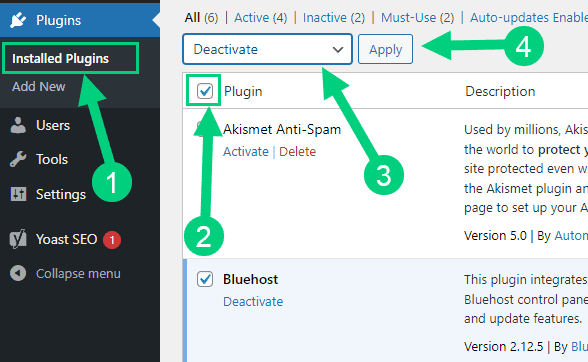
To install new plugins go to the WP Admin > Plugins > Add New.

On the plugins page:
❶ Search for the plugin you want in the search bar
❷ Click Install Now. Once you install the plugin, you must also activate the plugin for it to be enabled.
❸ If you are installing a paid plugin you can upload the plugin instead.

There are many different craft blog plugins that you can install, but here are the ones which we recommend:
Backup Plugin: A WordPress Backup Plugin creates backups of your website so you can restore it if something goes wrong.
Recommended Plugin: WPVivid (paid) or UpdraftPlus (free).
SEO Plugin: A WordPress SEO plugin helps you improve your website’s search engine ranking and visibility.
Recommended Plugin: RankMath (paid).
Google Analytics Plugin: A WordPress Google Analytics Plugin helps you collect data about how your website is being used. This data can then be used to improve your website’s performance.
Recommended Plugin: RankMath (paid) or GA Google Analytics (free).
Cache Plugin: A WordPress Cache Plugin stores a copy of your website’s pages and posts in a cache. When someone visits your website, the plugin will serve the cached pages instead of loading the pages from your server. This can speed up your website’s load time by up to 500%.
Recommended Plugin: WP Rocket (paid).
Page Builder Plugin: A WordPress Page Builder Plugin allows you to create and manage custom pages and posts with drag and drop.
Recommended Plugin: Thrive Architect (paid).
Security Plugin: A WordPress Security Plugin helps you protect your website from hackers and malware.
Recommended Plugin: Wordfence (free).
Social Media Plugin: A WordPress Social Share Plugin helps you share your content on social media websites.
Recommended Plugin: Easy Social Share Buttons (paid).
Email List & Lead Generation Plugin: A WordPress Email Opt-in Form Plugin helps you collect email addresses from your website’s visitors. This data can then be used to send them email newsletters, promote new blog posts, or sell products and services.
Recommended Plugin: Thrive Leads (paid).
Customize WordPress
Once you have installed your theme and plugins, it is time to customize the wordpress blog platform:
Change Colors, Fonts & Spacing
You can set the font, colors, and spacing by going to Appearance > Customize in your WordPress dashboard. Premium themes like GeneratePress allow you to customize every aspect of your blog.
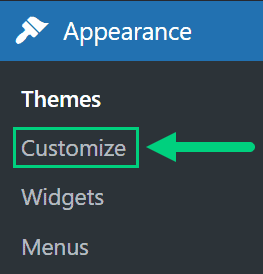
Check out our Blog Fonts & Typography guide to choose the right font and typography settings for your blog.
Add Your Logo
Get a logo designed for your blog from Fiverr. Then set the logo of your blog by going to Appearance > Customize in your WordPress dashboard. A logo is not required for a successful blog but it can definitely help appeal to your target audience.

Change Favicon
Favicon is the image that appears in the browser tab and bookmarks. Set the Favicon from the Appearance > Customize section of the WordPress dashboard.

Create Menus
The header and the footer menu can be set from the Appearance > Menus in your WordPress blog dashboard.

You can nest menu items so that it appears as a dropdown menu ❶. You can use the menu as your primary or secondary navigation menu ❷. Don’t forget to save your menu ❸.
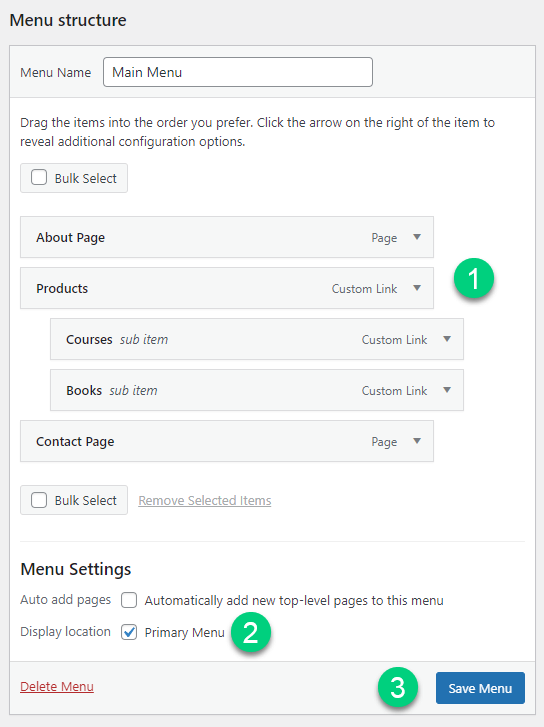
Create Widgets
If you have a sidebar, you can add widgets to it. Go to Appearance > Widgets in your WordPress admin dashboard.
Check out the list of the most useful Blog Widgets and how to add them to your blog.
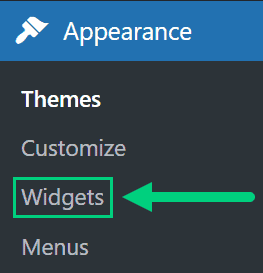
Set Title & Tag Line
The next step is to change your General Settings. Go to Settings > General in the WordPress Admin area.
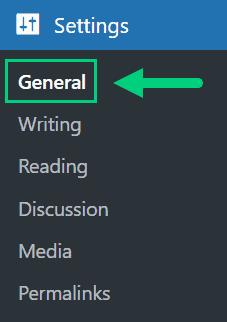
You can set your Site Title, Tagline, and Time Zone from this screen.
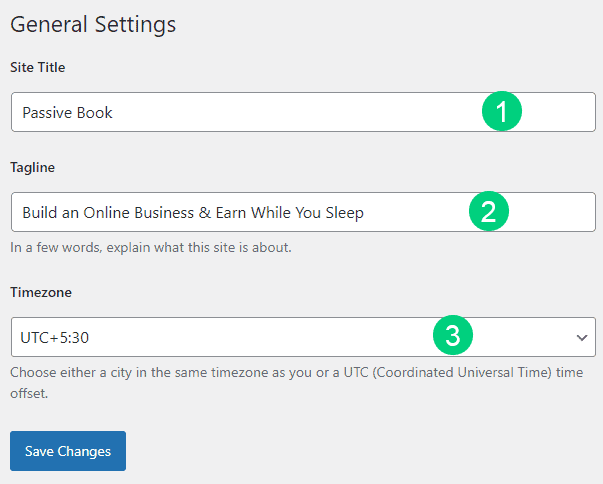
Set Permalinks
The ideal URL structure for SEO is yourdomain.com/sample-post. Set your permalink structure by going to Settings > Permalinks in your WordPress blog dashboard.
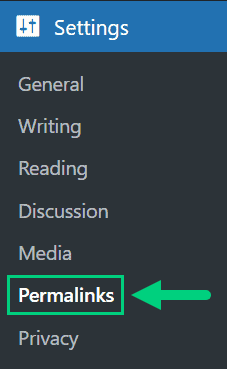
Select the “Post name” radio button and save changes.
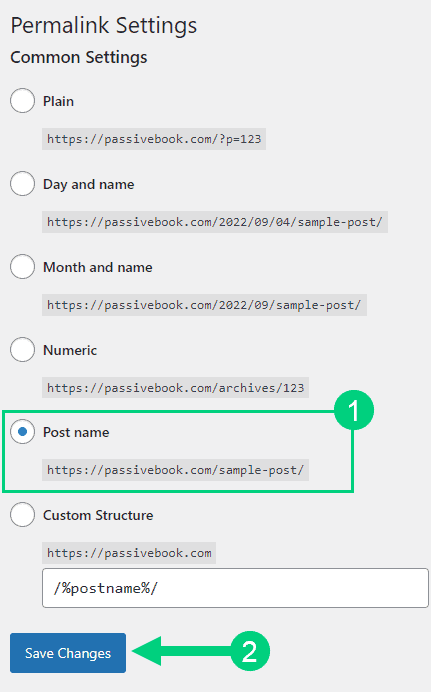
Enable Search Visibility
Chances are you want your blog to show up on Google so people can find you. Go to Settings > Reading in your WordPress dashboard.

To get search engine traffic, ensure the checkbox “Disable search engines from indexing this site” is Unchecked. You can find this option in Settings > Reading. Most of the time this should be unchecked by default but if it is not, then uncheck it to ensure your site gets traffic from search engines.
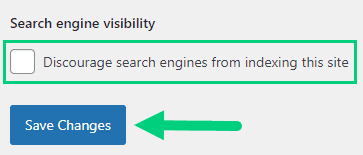
Adjust Comment Settings
Next, you will want to change the Discussion Setting (aka Comments). Go to Settings > Discussion in your WordPress admin area.
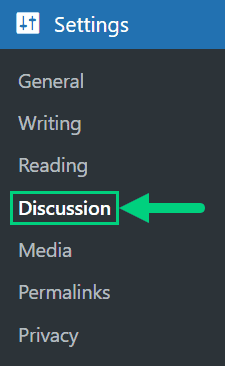
❶ You may want to enable or disable comments on this page. You can also disable pingbacks and enable comment moderation.
❷ You can also set comment approval settings.

If you want to design your blog further, check out our dedicated guide on blog design which has all our best blog design recommendations.
Create Static Pages
There are a few essential pages that you need to create for your craft blog before you can start blogging.
Use pages in WordPress to add static content. Go to WP Dashboard > Pages > Add New.
- Write the headline of your content.
- Populate the body content
- Click the publish button.
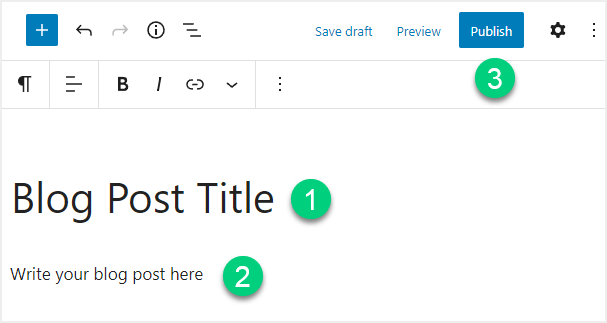
You may want to create the following pages:
Home Page
A home page is the main page of your website. It is the first page that your website’s visitors see when they visit your website. The home page typically contains an introduction to your website, a list of your latest blog posts, and a list of your latest products or services.

You can create a professional home page for your craft blog using a page builder like Thrive Architect.
About Page
An about page tells your website’s visitors who you are, what you do, and why they should care.
Your About page should include:
- A brief introduction to who you are and what you do
- A photo of yourself
- Your website’s mission statement
- Your contact information

Contact Page
A contact page allows your website’s visitors to get in touch with you.
Your contact page should include:
- Your name
- Your email address
- Your website’s URL
- A contact form
Use contact form plugins like Fluent Forms to create the form on your contact page.
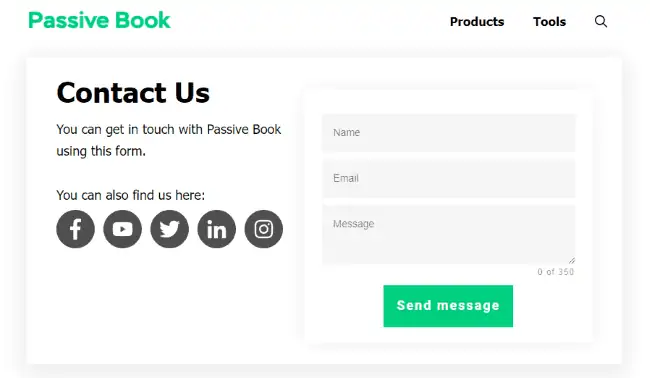
Privacy Policy
A privacy policy page tells your website’s visitors how you collect, use, and protect their personal information.
WordPress generates its own privacy policy for you. But you can also use a tool like Termly to generate your own privacy policy.
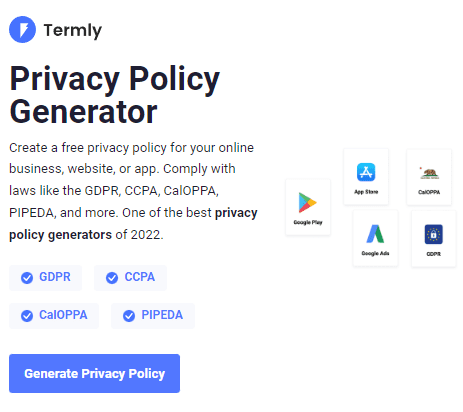
Terms of Service
A terms of service page is a legal document that outlines the terms and conditions that apply to your website.
Use a terms & conditions generator like Termly to create it.
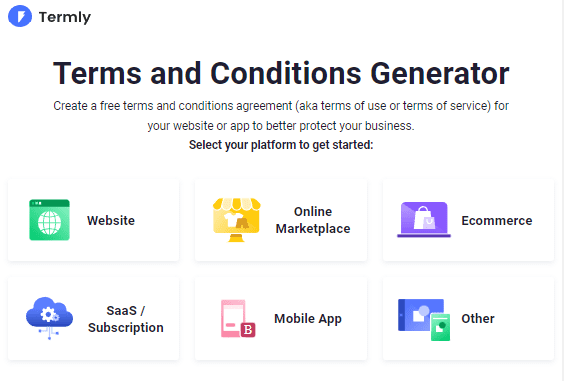
5. Write & Publish Blog Posts
Now that you have your craft blog set up, it’s time to write and publish your first blog post. To craft the perfect blog post, check out our in-depth guide on How to Write A Blog Post. Here we will go over specific tips for a craft blog.
1. Brainstorm Topics
You should brainstorm 100 topic ideas for your craft blog. This will ensure that you always have content to write about in your craft blog.
The goal is to find topics for your craft blog that your audience is searching for in Google. The type of content you write on your craft blog will depend on your specific niche.
Here are a few craft blog post ideas, you can potentially cover in your craft blog:
- How to Guides
- List Posts
- Tips
There are a few ways to brainstorm specific content:
Look at Competitors
If you want to be a successful craft blogger, you need to be constantly creating new content. But how do you come up with topic ideas?
One way is to look at the articles your competitors are writing about. This will give you an idea of what topics are popular in your niche, and it will help you come up with new content ideas.
To find competitor blog posts, do a Google search for your main keywords and scroll through the results. When you find an article that’s similar to what you want to write about, take a look at the tags and categories to get more ideas.
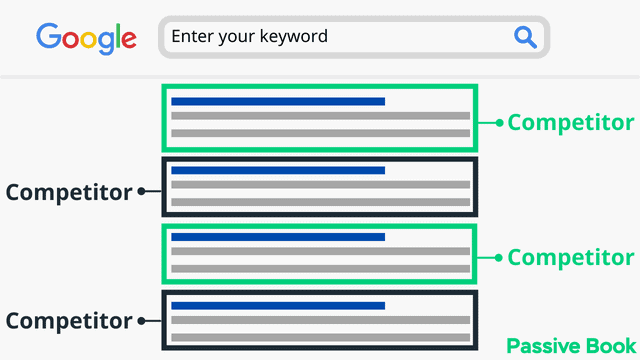
Do Keyword Research
One way to come up with additional blog post ideas for your craft blog is to do keyword research.
Keyword research is the process of finding keywords that people are searching for in Google. The best way to do keyword research is to use a tool like Keywordtool.io.
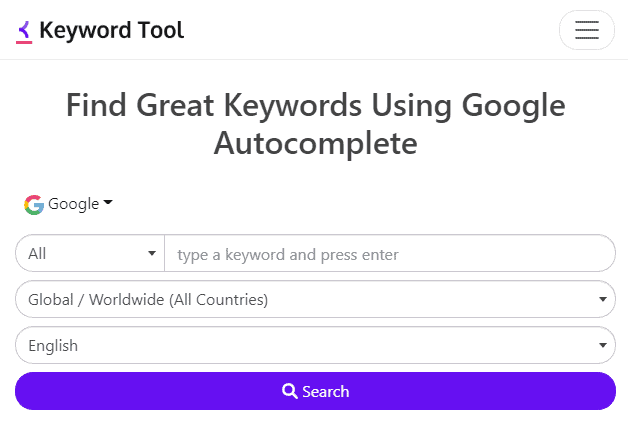
You can use keyword research to come up with ideas for how-to guides, list posts, and tips.
Community & Forums
Another way to come up with additional blog post ideas for your craft blog is to look for topics in online communities and forums.
Communities and forums are a great place to find ideas for blog posts because you can see what people are talking about and what they’re interested in.
You can also use communities and forums to get feedback on your blog posts and ideas.
2. Create an Editorial Calendar
An editorial calendar is a schedule of when you’re going to publish each piece of content. Creating an editorial calendar will help you stay organized and ensure that you’re publishing new content regularly.
Download Content Calendar Template

Steal our exclusive content calendar template. Have it delivered directly to your inbox:
There are a few different ways to create an editorial calendar.
If you prefer to manage your content manually, you can use a spreadsheet. To set up your editorial calendar with a spreadsheet, first list out all the topics that you want to write about in your craft blog. Then create columns for each of the following pieces of information:
- topic
- target keyword
- type of post
- publish date
- status
You can also use a tool like Trello or Notion to manage your editorial calendar.
3. Write a Blog Post
Now that you have a topic for your first blog post, it’s time to start writing.
How-To Articles
One of the most popular types of content in craft blogs is how-to articles. These are how-to guides that help readers learn how to do a craft project.
Here are a few examples of How-To posts:
- How to Make a Handmade Card
- How to Crochet a Scarf
- How to Embroider a Pillow
- How to Create a Macrame Wall Hanging
- How to Paint a Canvas Artwork
- How to Sew Your Own Dress
When writing how-to articles, it’s important to start with a strong introduction. This should include the topic and what your reader will learn in this post.
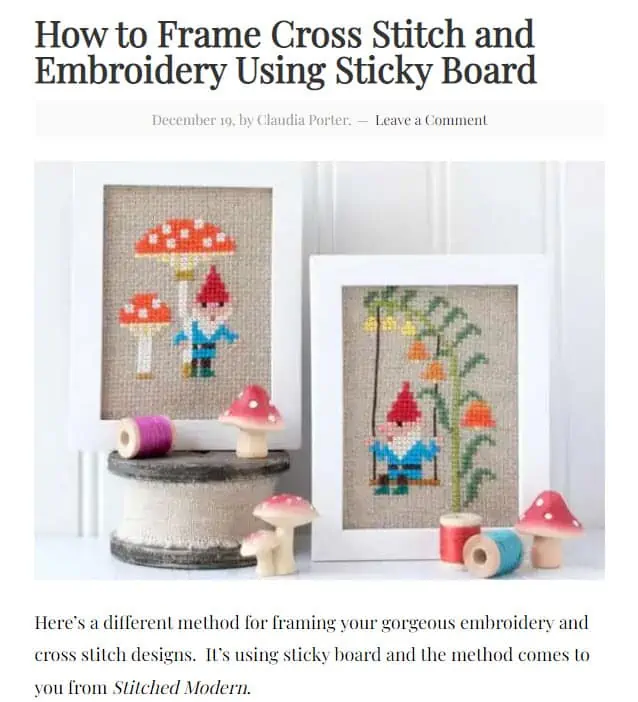
Next, break down your how-to into smaller pieces so it’s easy to follow. Each step should have its own heading.
Finally, don’t forget to include photos or videos to help illustrate each step. People are visual learners and adding pictures will make your how-to article more effective.
List Posts
Another popular type of content in craft blogs is list posts. These are articles that feature a list of items, tips, or ideas.
Here are a few examples of list posts:
- 43 Easy Holiday Décor Projects
- 19 Creative Ways to Use Mason Jars
- 3 Creative Cardmaking Tips
- 19 Amazing Scrapbooking Ideas
- 5 Embroidery Patterns to Try
When writing a list post, it’s important to start with an attention-grabbing headline. This will help your article stand out in the search results and get people to click through to read your article.
Next, introduce your topic and explain what readers will learn from your list post.
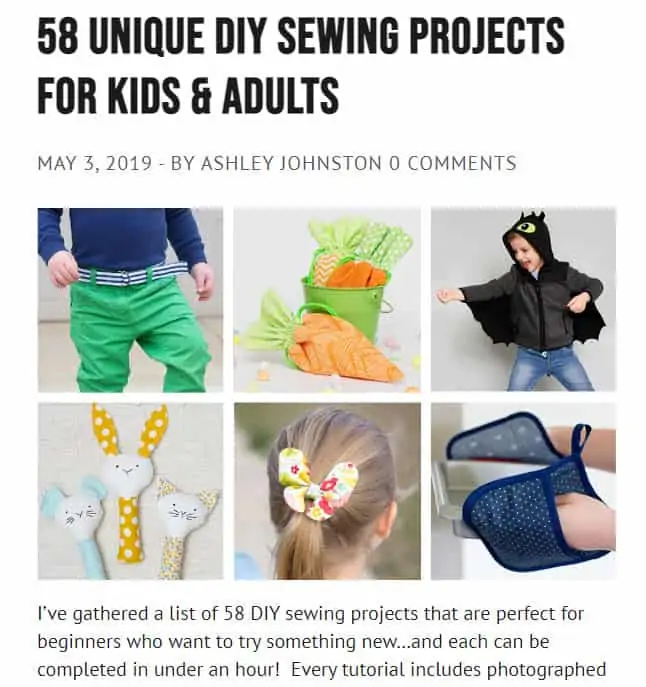
Once you’ve introduced your topic, start adding items to your list and write a brief summary for each one.
Use the most interesting item from your list as the first item.
Finally, don’t forget to include an engaging conclusion that wraps up your list post and leaves readers with something valuable.
Product Reviews
A product review is a written evaluation of a craft supply, tool, or product that you have used. Product reviews can help other crafters decide whether or not to purchase a particular item, and can also provide feedback to manufacturers and sellers.
Example blog post titles:
- “Supply Review: [Product Name]”
- “Tool Review: [Product Name]”
- “Product Review: [Product Name]”
- “Crafter’s Must-Haves: [Product Names]”
- “Disappointing Products: [Product Names]”
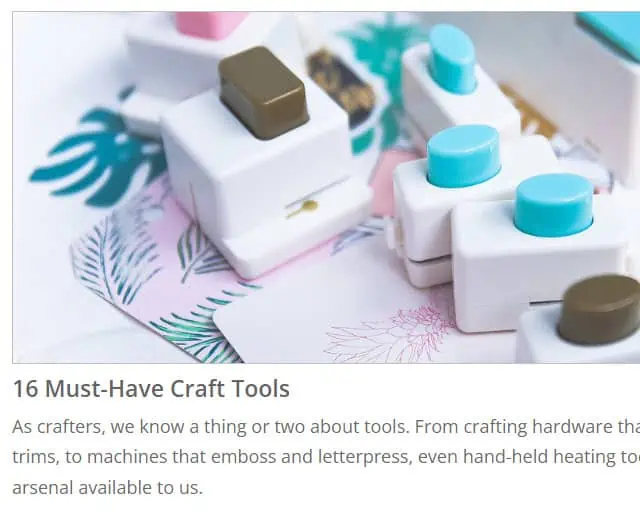
Start by summarizing the features and purpose of the product. Share your personal experience using the product, including any pros and cons that you observed. Consider including details about the quality, durability, and value of the product.
If you are reviewing a specific brand or type of product, compare it to similar products that you have used to provide context. Be honest in your review, but try to avoid being overly critical or negative. Consider including photos or videos to help illustrate your points.
Inspiration Posts
Inspiration posts are designed to spark creativity and provide ideas for craft projects. Inspiration posts can help crafters find new ideas, get out of a crafting rut, or discover new techniques or materials.
Example blog post titles:
- “Craft Project Ideas for [Season or Holiday]”
- “DIY Home Decor Ideas”
- “Gift Ideas for Crafters”
- “Inspiring Craft Rooms”
- “Crafty Quotes to Motivate Your Creativity”
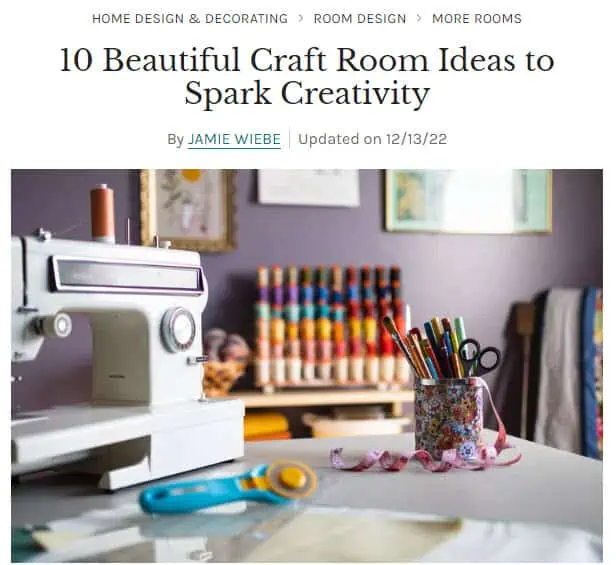
Start by identifying a theme or focus that you want to explore. Research and compile a list of ideas or images that fit the theme, and consider including personal anecdotes or experiences to add a personal touch.
Use descriptive language and include photos or images to help bring your ideas to life. Consider including links to relevant resources, such as tutorials or product recommendations, to help readers take the next step.
Collab Posts
A collaboration is a partnership between two or more people or organizations to create new content or achieve a common goal. Collaboration can be a great way to reach a new audience, create unique content, and build relationships within the crafting community.
Example blog post titles:
- “Collaboration with [Partner Name]: [Project Title]”
- “Guest Post by [Author Name]: [Post Title]”
- “Collaborative Craft Challenge: [Challenge Theme]”
- “Crafty Swap with [Partner Name]”
- “Crafty Collaboration: [Project Title]”

To write a collaboration post, start by identifying a potential partner or collaborator that you think would be a good fit for your blog. Reach out to them with a proposal, including details about the project or content that you would like to create together.
If your collaboration involves creating new content, work with your partner to brainstorm ideas and come up with an execution plan. Consider setting deadlines and establishing clear roles and responsibilities. Be sure to properly attribute any content that is contributed by your partner.
Craft Challenges
A craft challenge is an event or activity in which participants are invited to create a craft project based on a specific theme or set of guidelines. Craft challenges can be a fun way to get inspired, try new techniques, and connect with other crafters.
Example blog post titles:
- “Craft Challenge: [Challenge Theme]”
- “Join the [Challenge Theme] Craft Challenge”
- “Show Us Your [Challenge Theme] Crafts”
- “Craft Challenge Results: [Challenge Theme]”
- “Craft Challenge Round-Up: [Challenge Theme]”
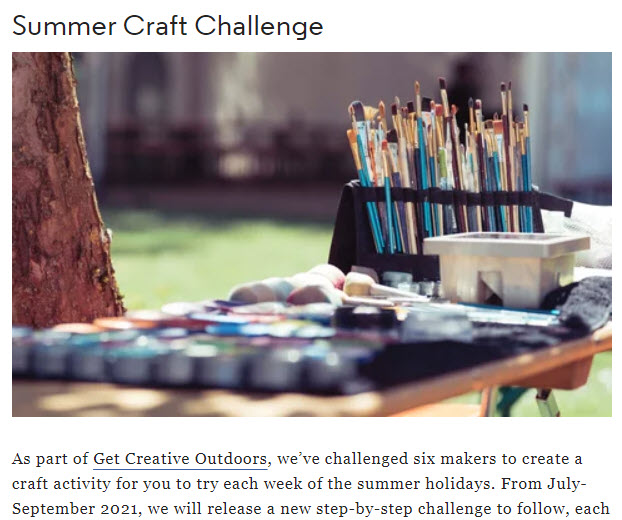
To write a craft challenge post, start by identifying a theme or focus for the challenge. Consider what materials or techniques you want to highlight, and set any necessary guidelines or rules for participation. Consider offering prizes or incentives for participants, and be sure to set a deadline for submissions.
Share details about the challenge on your blog and social media channels, and encourage readers to participate. Consider featuring submissions from participants on your blog, and provide feedback or commentary as appropriate.
Write 5x Faster With AI
You can write your new blog post at 5x speed using the AI writing software Jasper. I was able to write over a hundred blog articles in 3 months using Jasper. This blog article you are reading right now was written with the help of Jasper. AI will not only help you write blog posts fast but also with higher quality.
Jasper can write plagiarism-free blog content, articles, social media content, emails, and ad copy. All you have to do is provide a few inputs on what you want and Jasper will do all the hard work of creating the blog content for you. No more writer’s block.
Check out the video below to see Jasper in action:
Try Jasper for free using the links on this page and get 10,000 bonus credits you can use to start writing your first articles.
Once you sign up for Jasper I recommend you spend some time going through the tutorial videos in the Jasper Bootcamp to truly unlock the power of this amazing software.
Check out our guide on How to Write a Blog Post Fast in 15 mins Without Losing Quality for more tips to write fast.
Outsource Writing
If you’re finding it difficult to come up with new ideas or produce high-quality content consistently, one option is to outsource writing for your craft blog.
There are many different places where you can hire writers for your blog. You could use a site like Upwork or Fiverr, or try posting on job boards.
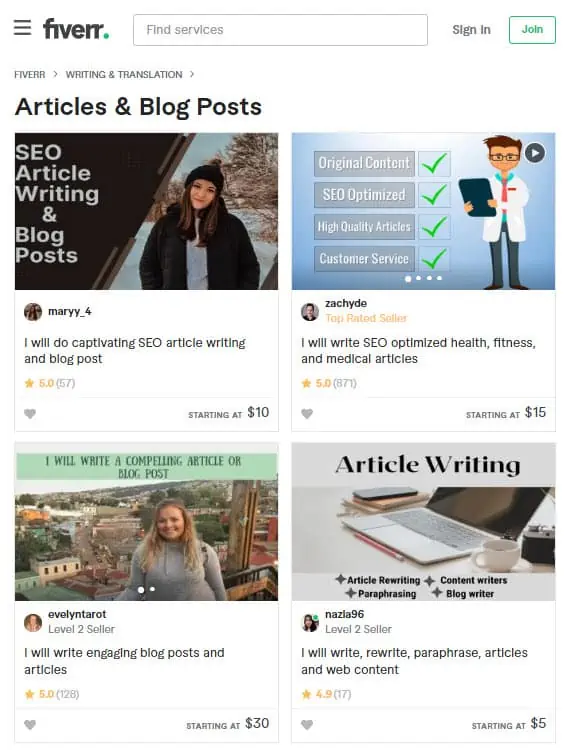
4. Add Images
People are visual learners, so it’s important to include images in your blog posts.
There are a few things to keep in mind when adding images to your blog posts.
First, make sure that you have permission to use the image. You can either take your own photos or use free stock photos.
Second, make sure that the images are relevant to your topic and add value to your article.
And finally, make sure that your images are optimized for the web. This means saving them in the correct file format and size. Use the jpeg file format for photos and png only for graphics. This will reduce the file size without compromising the image quality.

One of the best things about having a craft blog is that you can share your own creations with the world. And nothing captures your work better than a photo of your own handiwork.
When you’re taking photos of your crafts, it’s important to keep the following in mind:
- Use natural light whenever possible. This will help you capture the true colors and textures of your work.
- When taking photos of small items, try to use macro mode on your camera. This will allow you to get close up and create stunning images.
- Experiment with different angles and perspectives to find what works best for your crafts.
- And finally, make sure that your photos are in focus and well-lit.
Use Canva to create and edit images. Canva is a free online design tool that makes it easy to create beautiful images for your blog posts. You should consider upgrading to Canva Pro because it offers a free library of stock images that you can use in your blog posts. The images are high-quality and royalty-free, so you can use them without worrying about copyright issues. Plus, the library is constantly updated with new images so you can find the perfect image for your post.
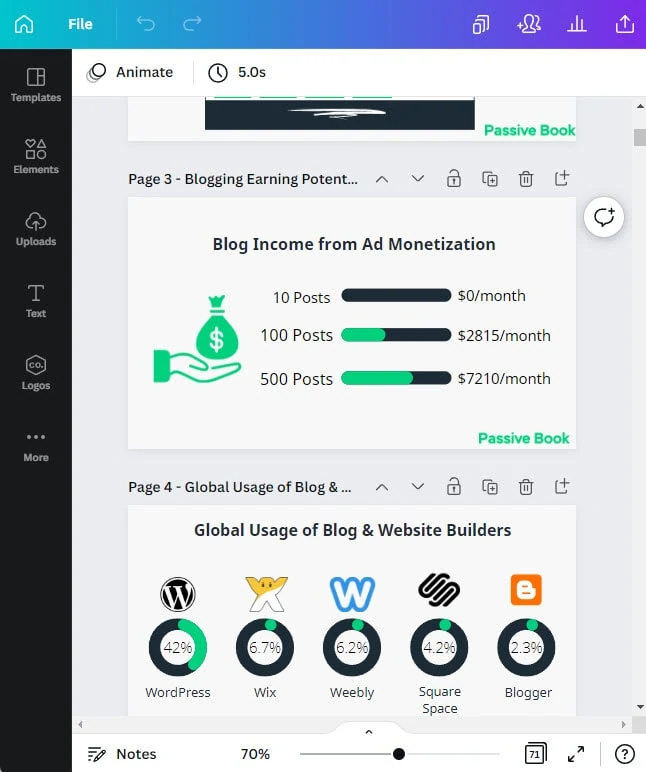
6. Promote Your Craft Blog
Once you have written your blog posts, it’s important to promote them as much as possible.
Search Engine Optimization (SEO)
SEO is the process of optimizing your website to rank higher in the search engine results pages (SERPs). When people are looking for information online, they typically use search engines like Google, Yahoo, or Bing. If your website appears in the top results for their query, you have a better chance of them clicking through and visiting your website.
There are many things that you can do to optimize your website for SEO. Here are a few tips:
- Use keyword-rich titles and descriptions for your pages and blog posts.
- Optimize your images by using the correct file formats and adding alt text.
- Add internal links from one page or blog post to another on your website.
Many factors go into SEO, and it can be a bit confusing to figure out where to start. You can master the more advanced SEO tactics by checking out our SEO Resources.

You can ensure you get the basics of SEO right, by completing the recommendations given by the RankMath plugin.
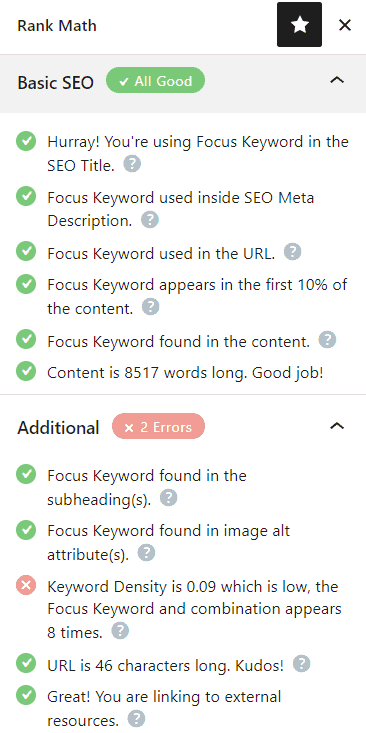
Email Marketing
Email marketing is an effective way to promote your craft blog and reach a wider audience. When you have new content on your blog, you can send an email newsletter to your subscribers with a link back to the article. This not only helps drive more traffic back to your site but also allows you to engage with your readers and get feedback on your content.
There are several email marketing platforms that you can use to deliver your newsletter. You can also create an email automation workflow to automatically send emails at specific intervals.
To get started with email marketing, you will need to build an email list. This can be done by adding a signup form on your website and encouraging people to subscribe when they visit. You should also consider promoting your newsletter on social media and in person through meetups and events.

You can use the Thrive Leads plugin to build opt-in forms to collect email addresses. You can then connect the opt-in form to an email marketing service like Active Campaign to send out the emails.
Check out our Email Marketing resources to learn more.
Social Media Marketing
Social media is a powerful platform for promoting your craft blog. By establishing a presence on social media, you can attract new readers and engage with existing followers.
There are many different social media platforms that you can use to promote your blog, but the most popular ones are Facebook, Twitter, Instagram, Pinterest, and YouTube. Each of these platforms has unique features and strategies to help optimize your marketing efforts.
For example, Instagram is a visual platform where you can share photos and short videos. You can post behind-the-scenes content of your work or how-to tutorials on how to do certain crafts.
Pinterest is another great option for promoting your craft blog as it’s hugely popular among crafters who use the platform to search for inspiration.
To get started with social media marketing, you will need to create profiles on the platforms that you want to focus on. Once you have created your profiles, it’s important to populate them with engaging content. This can include blog posts, images, infographics, and videos.
Guest blogging
Guest blogging is a great way to promote your blog and reach a new audience. When you guest blog on another website, you are allowed to write an article that will be published on their site. This article will include a link back to your own website, which helps drive traffic back to your site. You can also promote and link back to your blog from your author bio.
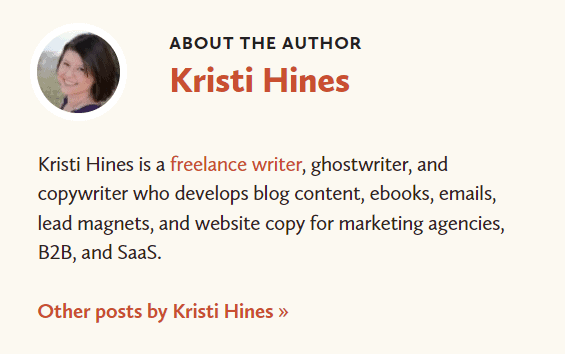
Guest blogging is also a great way to build relationships with other bloggers in your niche. When you contribute to another blog, you are allowed to connect with the blogger and their audience. This can help you expand your reach and grow your craft blog.
To get started with guest blogging, you will need to find websites that accept guest contributions. Once you have found a few sites that you would like to contribute to, you will need to pitch them an article idea. If they approve your article, you will then write the article and submit it to them for publication.
7. Make Money With a Craft Blog
Now that you know how to start a craft blog, it’s time to start monetizing your site so you can make money with your blog. There are several ways to monetize your blog, but the most common ones are advertising, affiliate marketing, digital products, and physical products.
Advertising
One of the simplest ways to monetize your blog is through advertising. You can work with ad networks to place ads on your website. When someone clicks or views your ads, you will earn money.
The amount of money that you earn will vary depending on the advertiser and the amount of traffic your blog gets.
To start advertising on your blog, you can sign up for an ad network like Ezoic (they pay more than Google Adsense). When your blog starts getting more than 100,000 page views a month you can monetize with Adthrive.
| Ad Network | Earnings Per 1K Impressions (EPM) | Monthly Traffic Requirement |
|---|---|---|
| Ad Thrive | $13 | 100,000 |
| Ezoic | $3 | 10,000 |
| Media.net | $1 | – |
| Google Adsense | $1 | – |
Affiliate Marketing
Another popular way to monetize your craft blog is through affiliate marketing. Affiliate marketing involves partnering with other businesses and promoting their products on your site. You can get affiliate links from an affiliate marketing network and place them inside your blog post. Whenever someone clicks your affiliate link and makes a purchase, you will earn a commission.
For example, you may partner with an online store that sells craft supplies and earn a commission for every sale that you refer. This can be a great way to generate passive income as the commissions typically add up over time.
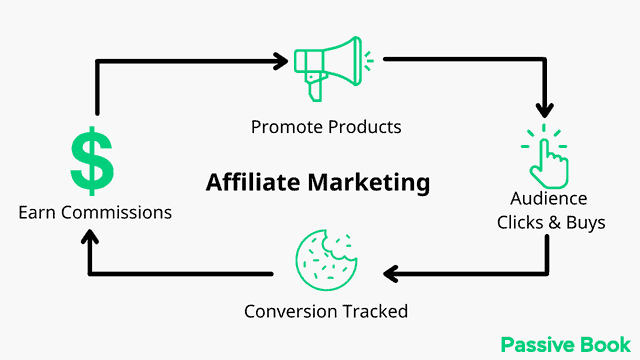
Digital Products
If you are looking for another way to make money from your blog, you may want to consider creating and selling digital products. Digital products can include ebooks, how-to guides, templates, stock photos, printables, and more.
Creating digital products can be a great way to generate passive income as you only have to create the product once and then you can sell it over and over again. You can sell your digital products on your own website or a marketplace like Etsy.
You can use Teachable if you want to sell video courses. Your students will have a dedicated course members area and a community system to ask questions and interact with each other. If you only want to sell eBooks, you can use SendOwl which lets you sell your digital products and eBooks for free.
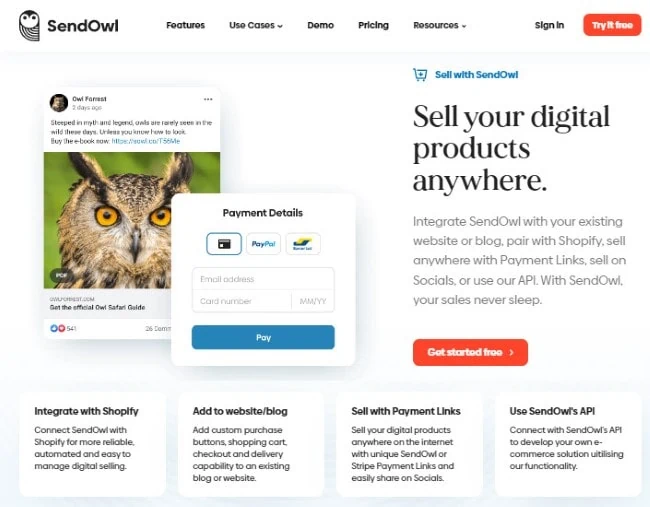
Physical Products
In addition to digital products, you may also want to consider selling physical products on your blog. Physical products can include crafts that you make, supplies that you sell, or even merchandise with your blog’s name or logo on it.
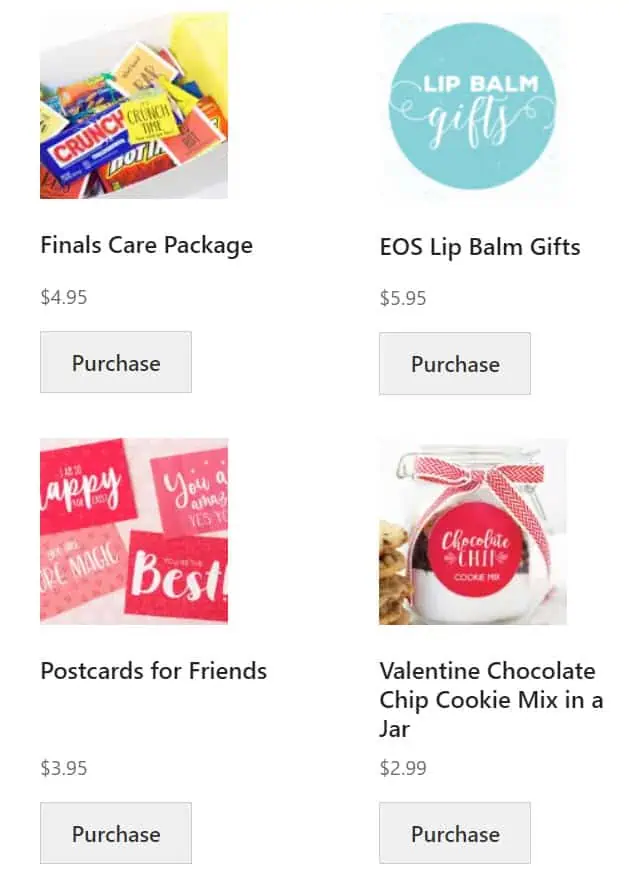
Selling physical products is a great way to monetize your blog if you have a passion for crafting. You can sell your products on your own website using the free Woocommerce plugin, on a marketplace like Etsy.
Sell Services
If you have a skill or talent that you can offer as a service, you may want to sell services on your blog. This can be a great way to monetize your blog if you have a unique skill or talent that others would be willing to pay for.
For example, you could offer design services, crafting services, or even blogging consulting services. You can sell your services on your own blog.
Sponsored Posts
Another way to monetize your craft blog is by writing sponsored posts for other businesses. Sponsored posts are paid posts that you write on behalf of another business.
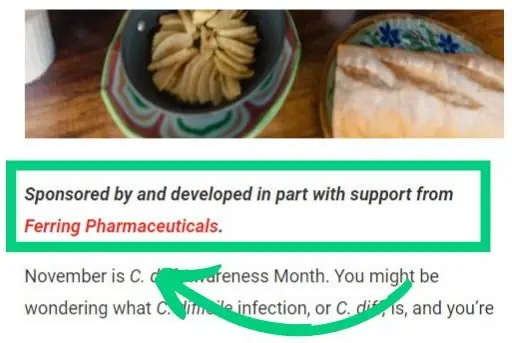
To get started with sponsored posts, you will need to reach out to businesses in your niche and pitch them your ideas. You can send potential clients a sample of your work or link to previous sponsored posts that you have written.
When you secure a sponsorship, be sure to include a disclaimer at the beginning or end of the post indicating that it has been paid for and that you may receive a commission if readers purchase any products mentioned in the post.
FAQ
Here are a few frequently asked questions:
How do I start a blog with no experience?
If you have no experience starting a blog, don’t worry – it’s easy to get started. Just follow the steps outlined in this guide and you will be able to build a successful crafts blog in no time.
Do craft blogs make money?
Yes, craft blogs can make money in several different ways. Some common monetization strategies include advertising, affiliate marketing, digital products, and physical products. You may also be able to sell services or write sponsored posts on behalf of other businesses.
It’s important to choose a monetization strategy that fits with the type of content you produce and how you want to run your blog. With the right approach, craft blogs can make a substantial amount of money over time.
How do I start a craft blog?
Starting a craft blog is relatively easy and can be done in a few simple steps. First, you will need to choose a niche and register a domain name. Once you have set up your blog, you can start writing quality content and promoting it to attract readers.
If you want to make money from your blog, you will need to choose a monetization strategy and implement it on your site. With the right approach, you can start earning money from your craft blog.
What do you write in a craft blog?
There is no one answer to this question, as the content of craft blogs can vary widely. However, some common topics that you could write about include how-to guides for crafting projects, reviews of new craft supplies or tools, tips on how to start a successful blog, and more.
When writing your posts, it’s important to be creative and stay focused on your niche so that you can capture the interest of your target audience. Additionally, you should try to produce high-quality content that truly resonates with your readers to build a loyal following over time.
What Next?
A craft blog can be a great way to share your crafting skills with the world and make some money while you’re at it.
We hope this guide showed you how to start a craft blog.
If you have any questions as you set up your new blog, leave a comment below so we can help you out.
Have you started your craft blog yet? What type of craft blog are you going to start? Let us know in the comments.
Share this post with your friends & followers:
